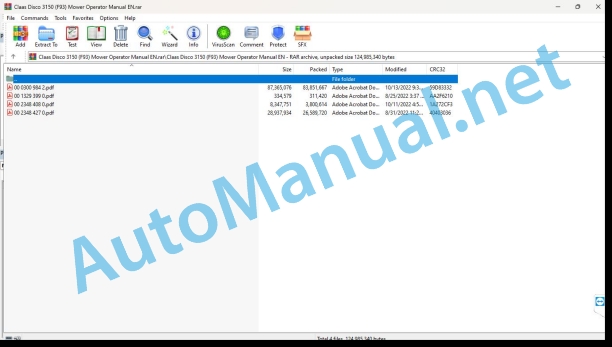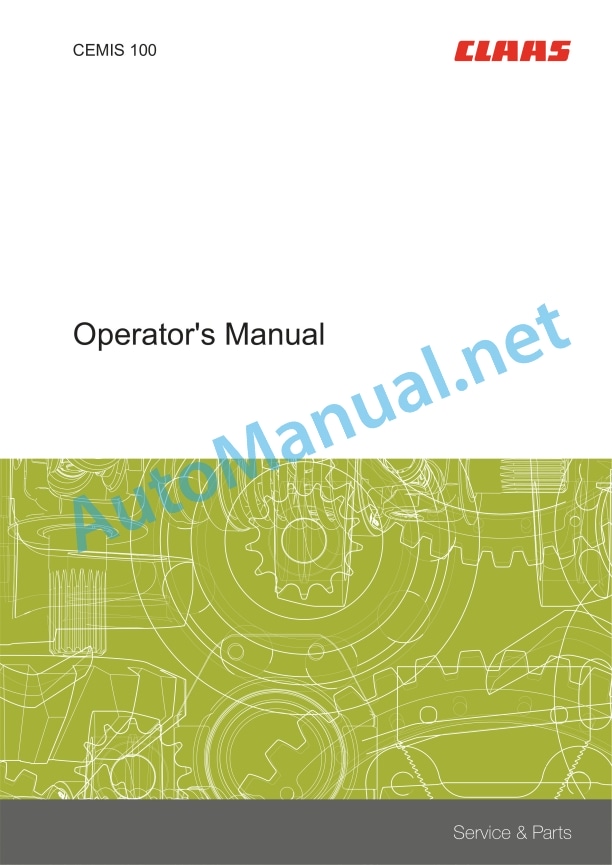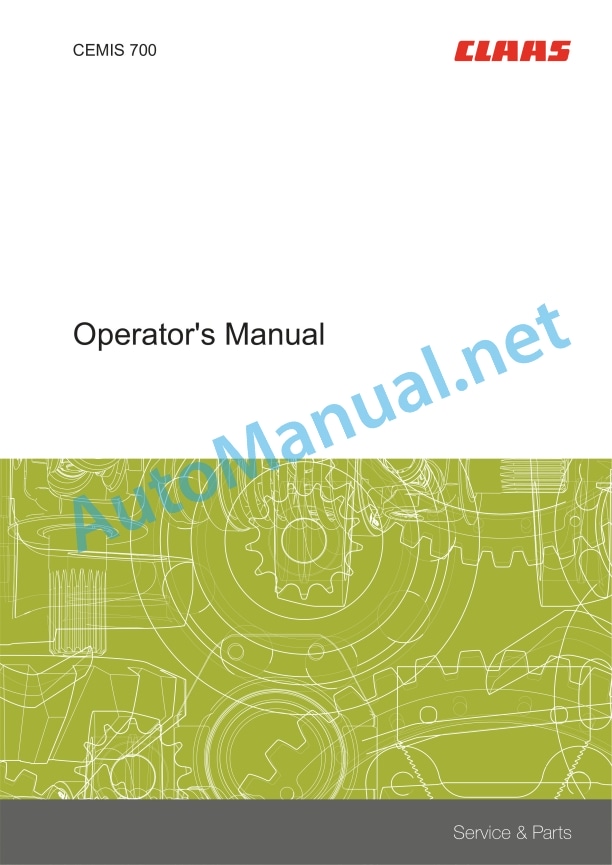Claas Disco 3150 (F93) Mower Operator Manual EN
$50.00
- Model: Disco 3150 (F93) Mower
- Type Of Manual: Operator Manual
- Language: EN
- Format: PDF(s)
- Size: 109 MB
File List:
00 0300 984 2.pdf
00 1329 399 0.pdf
00 2348 408 0.pdf
00 2348 427 0.pdf
00 0300 984 2.pdf:
DISCO 3150 TCDISCO 3150 TRCDISCO 3150 TC FLAPGROUPER
Table of contents
1 Introduction
1.1 Notes on the manual
1.1.1 Validity of the manual
1.1.2 Information about this Operator’s Manual
1.1.3 Symbols and notes
1.1.4 Optional equipment
1.1.5 Qualified specialist workshop
1.1.6 Notes on warranty
1.1.7 Spare parts and technical questions
1.2 Intended use
1.2.1 Intended use
1.2.2 Reasonably foreseeable misuse
2 Safety
2.1 Identifying warnings
2.1.1 Hazard signs
2.1.2 Signal word
2.2 Safety rules
2.2.1 Importance of Operator’s Manual
2.2.2 Observing safety decals and warnings
2.2.3 Requirements for all persons working with the machine
2.2.4 Children in danger
2.2.5 Hazard areas
2.2.6 Staying between the tractor and the machine
2.2.7 Hitching the tractor to the machine
2.2.8 Risk of injury from rotating shafts
2.2.9 Structural changes
2.2.10 Optional equipment and spare parts
2.2.11 Control of the machine while it is running
2.2.12 Only use once properly put into operation
2.2.13 Technical condition
2.2.14 Danger resulting from damage to the machine
2.2.15 Complying with technical limit values
2.2.16 Danger from machine parts running on
2.2.17 Keeping the safety devices functional
2.2.18 Personal protective equipment
2.2.19 Wearing suitable clothing
2.2.20 Removing dirt and loose objects
2.2.21 Preparing the machine for road travel
2.2.22 Hazards when driving on the road and in the field
2.2.23 Parking the machine safely
2.2.24 Unsupervised parking
2.2.25 Unsuitable operating materials
2.2.26 Safe handling of operating materials and auxiliary materials
2.2.27 Environmental protection and disposal
2.2.28 Fire prevention
2.2.29 Lethal electrocution from overhead lines
2.2.30 Behaviour in case of voltage flash-over from overhead lines and when lightning strikes
2.2.31 Noise may cause health damage
2.2.32 Liquids under pressure
2.2.33 Hot surfaces
2.2.34 Only carry out work on the machine when it is stopped
2.2.35 Maintenance operations and repairs
2.2.36 Raised machine parts and loads
2.2.37 Danger from welding work
2.3 Safety marking
2.3.1 Layout of safety decals
2.3.2 Safety decals on the machine
3 Machine description
3.1 Overview and method of operation
3.1.1 Machine overview
3.1.2 Overview of the cutting disc direction of rotation
3.1.3 Function of DISCO 3150 TC / 3150 TC FLAPGROUPER
3.1.4 Function of DISCO 3150 TRC
3.2 Optional equipment
3.2.1 High-cut skids*
3.2.2 Double high-cut skids*
3.2.3 Wear skids*
3.2.4 Bar protection*
3.2.5 Slip-on yoke for 8-piece universal drive shaft*
3.2.6 Slip-on yoke for 21-piece universal drive shaft*
3.2.7 1-part hydraulic connectors*
3.2.8 Crop spreader*
3.2.9 Lighting adapter for USA*
3.2.10 Legal technical equipment in the European Union*
3.2.11 Legally prescribed technical equipment for Switzerland*
3.3 Identification plates and vehicle identification number
3.3.1 Machine identification plate
3.3.2 Machine identification plate
3.4 Information on the machine
3.4.1 Stickers on the machine
4 Operating and display elements
4.1 Controls
4.1.1 Mower unit
4.1.2 Mower unit
4.1.3 Hydraulic hose
4.1.4 Pull rope
5 Technical specifications
5.1 DISCO 3150 TC
5.1.1 Dimensions
5.1.2 Weights
5.1.3 Requirements for the tractor
5.1.4 Version
5.1.5 Tyre pressure
5.1.6 Sound pressure level
5.1.7 Lubricants
5.2 DISCO 3150 TRC
5.2.1 Dimensions
5.2.2 Weights
5.2.3 Requirements for the tractor
5.2.4 Version
5.2.5 Tyre pressure
5.2.6 Sound pressure level
5.2.7 Lubricants
5.3 DISCO 3150 TC FLAPGROUPER
5.3.1 Dimensions
5.3.2 Weights
5.3.3 Requirements for the tractor
5.3.4 Version
5.3.5 Tyre pressure
5.3.6 Noise level
5.3.7 Lubricants
6 Machine preparation
6.1 Switching off and securing the machine
6.1.1 Switching off and securing the tractor and machine
6.2 Accessing workplaces and maintenance spaces
6.2.1 Opening and closing the safety device
Opening bonnet
Closing bonnet
6.2.2 Opening the belt drive safety device
6.3 Adapting the tractor
6.3.1 Checking the protective guard on the tractor PTO shaft
6.4 Adapting the machine
6.4.1 Checking the universal drive shaft length
Shortest working position of the universal drive shaft
Longest working position of the universal drive shaft
6.4.2 Adapting the universal drive shaft length
6.4.3 Fitting the PTO shaft to the machine
6.4.4 Attaching the double high-cut skids*
6.4.5 Installing the high-cut skids*
6.4.6 Removing the high-cut skids*
6.4.7 Installing wear skids*
6.4.8 Adapting the lateral offset
6.4.9 Changing the PTO speed
6.4.10 Filling the tyres
6.5 Hitching the machine
6.5.1 Remove safety lock*
6.5.2 Hitching up the hitch bracket
6.5.3 Swinging up the stand
6.5.4 Installing the universal drive shaft
6.5.5 Fitting the safety chain*
6.5.6 Connecting the hydraulic hose for lifting
6.5.7 Connecting the hydraulic hose for slewing
6.5.8 Connecting the lighting cable
6.5.9 Laying the pull rope
6.6 Unhitching the machine
6.6.1 Removing the pull ropes
6.6.2 Swinging the stand down
6.6.3 Unplugging the lighting cable
6.6.4 Disconnecting the hydraulic hose for slewing
6.6.5 Disconnecting the hydraulic hose for lifting
6.6.6 Removing the universal drive shaft
6.6.7 Removing the safety chain*
6.6.8 Unhitching headstock
6.6.9 Fit safety lock*
6.7 Prepare road travel
6.7.1 Lifting the mower unit
6.7.2 Slewing to transport position
6.7.3 Slewing to transport position
6.7.4 Closing shut-off taps
6.7.5 Folding up the safety frame
6.7.6 Marking the machine for road travel
6.7.7 Performing checks prior to road travel
6.8 Preparing the working position
6.8.1 Slewing to working position
6.8.2 Slewing to working position
6.8.3 Folding down the safety frame
6.8.4 Lowering the mower unit
6.9 Loading the machine
6.9.1 Lifting the machine
7 Operation
7.1 Driving on the road
7.1.1 Driving on public roads
7.2 Fieldwork settings
7.2.1 Adjusting the mower head load relief
7.2.2 Adjusting the lifting height
7.2.3 Adjusting the cutting height
7.2.4 Adjusting the tine conditioner
7.2.5 Changing the tine conditioner speed
7.2.6 Adjusting the roller conditioner
7.2.7 Adjusting the swath width
7.2.8 Adjusting the swath width
7.2.9 Arresting the swathing plates
7.2.10 Adjusting the crop spreader*
7.3 Fieldwork
7.3.1 To be observed during fieldwork
7.3.2 Machine use
7.3.3 Mowing with double swaths
7.3.4 Adapting the PTO shaft speed
7.3.5 Mowing methods
7.3.6 Lifting the machine to the headland position
7.3.7 Instructions for mowing
7.3.8 Difficult operating conditions
7.3.9 Recommendation for environmental protection
8 Faults and remedies
8.1 Overview of problems
8.1.1 Problems on the machine
8.2 Electric system
8.2.1 Defective incandescent lamps
8.2.2 Defective incandescent lamps
8.3 Chassis
8.3.1 Changing the transport trailer wheel
8.3.2 Changing the transport trailer wheel
8.4 Mower unit
8.4.1 The cutting disc no longer turns
9 Maintenance
9.1 Service interval overview
9.1.1 Before the harvest
9.1.2 After the first 10 operating hours
9.1.3 After the first 50 operating hours
9.1.4 Every 8 operating hours
9.1.5 Every 50 operating hours
9.1.6 Every 100 operating hours
9.1.7 Every 250 operating hours
9.1.8 Every 500 operating hours or annually
9.1.9 Every 5 years
9.1.10 After the harvest
9.2 Gearbox
9.2.1 Checking the gearbox for leaks
9.2.2 Check the oil level in the main gearbox
9.2.3 Check the oil level of the angle drive
9.2.4 Changing the oil in the main gearbox
9.2.5 Changing the oil in the angle drive
9.3 Universal drive shafts
9.3.1 Service the universal drive shaft
9.4 Clutches
9.4.1 Checking the overload clutch
9.4.2 Venting the friction clutch
9.4.3 Checking the friction discs
9.4.4 Clean the friction clutch on the universal drive shaft
9.5 Chassis
9.5.1 Check the tyre pressure
9.5.2 Checking the wheel nuts of the transport running gear
9.5.3 Checking the wheel nuts of the transport running gear
9.6 Hydraulic system
9.6.1 Checking the hydraulic hoses
9.7 Mower unit
9.7.1 Check the oil level in the mower head
9.7.2 Changing the oil in the mower head
Draining oil
Topping up oil
9.7.3 Check the mower knives
9.7.4 Replacing the mower knives
9.7.5 Check the mower knife holder
9.7.6 Check the adapters
9.7.7 Clean the drain opening of the feed drum
9.7.8 Check the feed drum wear bars
9.7.9 Check the cover plate on the feed drum
9.7.10 Check the sealing washer of the feed drum
9.7.11 Check the cutting discs
9.7.12 Replacing the cutting discs
9.7.13 Adjust the anti-wrap guard
9.8 Crop processing unit
9.8.1 Checking the conditioner drive belt
9.8.2 Changing the conditioner drive belt
9.8.3 Tensioning the conditioner drive belt
9.8.4 Tensioning the conditioner drive belt
9.8.5 Checking the tines
9.8.6 Adjusting the synchronous running of the roller conditioner
9.8.7 Adjusting the roller clearance
9.8.8 Adjusting the compression spring of the roller conditioner
9.9 Assembly parts and bodywork
9.9.1 Removing harvesting residues
9.9.2 Clean the machine
9.9.3 Preserve the machine
9.9.4 Check the fittings
9.10 Lubrication plan
9.10.1 Lubricate lubrication points every 50 operating hours
9.10.2 Lubricating grease points every 100 operating hours
9.10.3 Lubricate grease points every 250 operating hours
10 Putting out of operation and disposal
10.1 General information
10.1.1 Putting out of operation and disposal
11 EC declaration of conformity
11.1 DISCO 3150 TC / 3150 TRC / 3150 TC FLAPGROUPER
11.1.1 EC Declaration of Conformity
12 Technical terms and abbreviations
12.1 Terms and explanations
12.1.1 Technical terms
12.1.2 Abbreviations
00 2348 408 0.pdf:
CEMIS 100
Table of contents
1 Introduction
1.1 General information
1.1.1 Validity of the manual
1.1.2 Information about this Operator’s Manual
1.1.3 Symbols and notes
1.2 Intended use
1.2.1 Intended use
1.2.2 Reasonably foreseeable misuse
2 Safety
2.1 Safety rules
2.1.1 General safety and accident prevention regulations
2.1.2 Interaction between terminal and machine or tractor
2.1.3 Electrocution by electrical system
3 Product description
3.1 Overview and method of operation
3.1.1 Overview of CEMIS 100
3.1.2 Function principle of CEMIS 100
3.2 Identification plates and identification numbers
3.2.1 Spare parts and technical questions
3.2.2 Identification plate of CEMIS 100
4 Operating and display elements
4.1 CEMIS 100
4.1.1 User interface for LINER
4.1.2 User interface for ROLLANT
4.1.3 User interface for UNIWRAP
5 Technical specifications
5.1 CEMIS 100
5.1.1 Specification
6 Operation
6.1 CEMIS 100
6.1.1 Operating the CEMIS 100
6.1.2 Switching CEMIS 100 on
6.1.3 Switching CEMIS 100 off
7 Maintenance
7.1 CEMIS 100
7.1.1 Daily
8 Putting out of operation and disposal
8.1 General information
8.1.1 Removal from service and disposal
9 Technical terms and abbreviations
9.1 Terms and explanations
9.1.1 Technical words
9.1.2 Abbreviations
00 2348 427 0.pdf:
CEMIS 700
Table of contents
1 Introduction
1.1 General information
1.1.1 Validity of the manual
1.1.2 Information about this Operator’s Manual
1.1.3 Symbols and notes
1.2 Intended use
1.2.1 Intended use
1.2.2 Reasonably foreseeable misuse
2 Safety
2.1 Safety rules
2.1.1 General safety and accident prevention regulations
2.1.2 Interaction between terminal and machine or tractor
2.1.3 Electrocution by electrical system
3 Product description
3.1 Overview and method of operation
3.1.1 Overview of CEMIS 700
3.1.2 Function principle of CEMIS 700
3.2 Identification plates and identification numbers
3.2.1 Spare parts and technical questions
3.2.2 Identification plate of CEMIS 700
4 Information on the product
4.1 Software version
5 Operating and display elements
5.1 CEMIS 700
5.1.1 User interface
5.1.2 Terminal program
6 Technical specifications
6.1 CEMIS 700
6.1.1 Specification
7 Operation
7.1 CEMIS 700
7.1.1 Operating the CEMIS 700
7.1.2 Switching CEMIS 700 on
7.1.3 Switching CEMIS 700 off
7.2 Terminal settings
7.2.1 Making settings
Making settings with the rotary button
Making settings with the touch function
7.2.2 Setting the screen lighting
Daytime mode
Nighttime mode
Activating automatic key lighting
7.2.3 Setting the time and date
7.2.4 Displaying diagnosis information
On-board power supply voltage display
Display of CLAAS ISOBUS ECU address and name
7.2.5 Setting the language and display formats
Setting the language
Setting display formats
7.2.6 Setting the volume
7.2.7 Deleting an ISOBUS implement
8 Maintenance
8.1 Maintenance
8.1.1 Daily
9 Putting out of operation and disposal
9.1 General information
9.1.1 Removal from service and disposal
10 Technical terms and abbreviations
10.1 Terms and explanations
10.1.1 Technical words
10.1.2 Abbreviations
John Deere Repair Technical Manual PDF
John Deere Repair Technical Manual PDF
John Deere Application List Component Technical Manual CTM106819 24AUG20
John Deere Repair Technical Manual PDF
John Deere Repair Technical Manual PDF
John Deere Parts Catalog PDF
John Deere Harvesters 8500 and 8700 Parts Catalog CPCQ24910 Spanish
John Deere Repair Technical Manual PDF
John Deere Parts Catalog PDF
John Deere Tractors 7500 Parts Catalog CPCQ26568 30 Jan 02 Portuguese
John Deere Repair Technical Manual PDF
John Deere Repair Technical Manual PDF
John Deere Transmission Control Unit Component Technical Manual CTM157 15JUL05

























